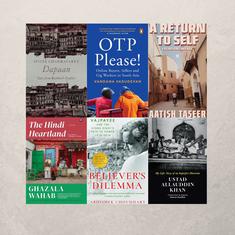I have always struggled to explain to my friends that even though I am writing a dissertation on medieval Indian history, it is not about the Mughal Empire. That medieval Indian history is not just about the Mughals comes almost as a revelation to them. But this is not entirely their fault. In India, middle school history textbooks give unprecedented importance to the Mughal Empire as compared to its contemporaries in the South and East.
It’s not just middle school. The current NCERT textbook for high school students devotes two of five chapters on medieval Indian history solely to the Mughals. In school, I too was exposed to a similar framework, but I was lucky that my tryst with history took me far enough to realise that there is more to the medieval era than just the Mughals. Not all of us are so lucky.
Hegemony of the North
The disconcertingly disproportionate space the Mughals enjoy in our medieval Indian history textbooks is primarily because of the dominance of North India over the rest of the country. The hegemony of the North alienates us from a host of other histories that merit equal, if not more, attention. It stifles several vibrant strands of history during that era, which must be brought to the fore. This bias permeates not just medieval history, but the history of the Indian subcontinent as a whole. This is why even ancient India is all about the Mauryas and the Guptas of the North, while the Pallavas and Cheras of the South find no mention.
In the small chance that these parallel empires make it to our textbooks, it is always in relation to the Mughal Empire. I clearly remember reading about Bijapur, the seat of the Adilshahis of the Deccan only with reference to the invasion of the Mughal ruler, Aurangzeb. Similarly, Bengal is mentioned only when Jehangir captured it. This bias can be attributed to the obsession most British historians have with the opulence, art and architecture of the Mughal empire that we have inherited, much like the other biases of the British.
That the legacy of the Mughal Empire merits a special place in our history is indisputable. But it should be one of several strands of the subcontinent’s medieval history, and not come to dominate it. Thus, while removing Mughal history from our textbooks altogether would be a grave injustice to a fascinating historical narrative, reducing the space it currently occupies would help make it more representative of medieval India.
Fascinating histories
If this is done, several other strands of history can be introduced in our textbooks, such as that of the five Deccan sultanates, which struggle to find a mention at present. In its heyday, Bijapur – the seat of the Adilshahi dynasty (in present-day Karnataka) – flourished as the centre of production of some of the finest specimens of Deccani painting and lovely illuminated manuscripts and muraqqas (albums containing miniature paintings and calligraphy), much before Mughal emperor Jehangir’s famed muraqqas.
The architecture of Bijapur surpasses that of the Mughals in terms of its detailed carving and beautiful arabesques as seen in the buildings of Mehtar Mahal and Ibrahim Rauza. Ibrahim Adil Shah II, the most famous ruler of the Adilshahis, was a great connoisseur of the arts, especially music. A contemporary of Akbar, Ibrahim’s keen interest in Hinduism and his cosmopolitan attitude towards religion, earned him the title of Jagadguru (preceptor of the world) much before Akbar’s policy of sulh-e-kul or universal peace.
Further south, the history of the Zamorin or the Hindu ruler of Calicut (Kozhikode) is seldom mentioned in school textbooks either. During the medieval era, Calicut was one of the largest trading centres of the world and hosted several sets of migrants – Portuguese, French and the British – who contributed to its fascinating cultural history. The port city lay on the medieval Spice Route and was coveted by the Portuguese and the French, but the Zamorin continued to control Calicut till the 18th century by giving the European powers only the trading rights of the port and keeping the judicial and administrative authority with himself. Mosques made without the archetypical dome and arch architecture (such as the Miskaal mosque in Kuttichera) and gorgeous temples built under the aegis of the Zamorin (such as the Tali Shiva temple) are a sight to behold. They constitute a culture that is rarely mentioned in our history books.
In the East
An equally interesting history is that of the Ahom kings of Assam. Even though the Mughal forces were considered a formidable force in medieval India, they were defeated twice by the powerful Ahom army – comprising the paiks – in the battles of Itakhuli and Saraighat. In quieter times, the paiks were employed in public works and it was because of this that high embanked roads and enormous tanks came into existence in Upper Assam. Bhakti and Sufi traditions also made their way into Assam giving birth to Vaishnavite saints such as Shankardeva and Sufi saints such as Ajaan Fakir. Traditions such as shravana kirtana and bargeet (devotional songs) were also followed.
The history of the tribes subsisting alongside the “settled communities” of Medieval India is by far the most grossly underrepresented in our textbooks. The Gond kingdom of Garha Katanga took to trading with “settled communities” due to the rapid commercialisation of agriculture and the vigorous clearing of forests. This opening up of their society allowed caste barriers to emerge, with Gond rajas styling themselves as Rajputs and giving land grants to the Brahmins.
Sadly, these fascinating bits of medieval history find no place in our textbooks. The Mughal Empire’s grandeur overshadows each and every one of its contemporaries. This irksome dominance of North Indian history over histories from other regions of India is fast leading to the loss of a significant part of the subcontinent’s heritage. If we are to stop this from happening we must reduce Mughal history from school textbooks.












